Dream Jobs: Icelandic Horse Trainer and Equestrian Performer
Gudmar Petursson shares his experiences riding with the Knights of Iceland and how he became a respected trainer of Icelandic Horses.
by Karen Braschayko
You may have seen Gudmar Petursson presenting at equine expos, conducting clinics or performing with his show team Knights of Iceland. He has also toured with “Apassionata: The Beginning,” showcasing the Icelandic Horse and sharing his artistry and horsemanship with thousands.
Petursson is a top-notch trainer and an ambassador for his breed. He has earned the second highest number of Icelandic championship titles ever, and he was granted the highest degree offered by Holar University, an equine science college in Iceland. He was a certified FT competition trainer and instructor before he created his performance team. Knights of Iceland is a thrilling equestrian show of tolting with flasks of beer, riding the flying pace through lines of fire, and demonstrating drill work with sparklers in the horses’ legs. He runs a breeding operation in Iceland and has about 30 horses at his training farm in Louisville, Kentucky.
So how did he get here, and how does he manage it all? Petursson shares with us how he follows his dreams, how he encourages others, and how teamwork helps him keep everything together.
Karen Braschayko for Equitrekking: What is your background with horses?
Gudmar Petursson: I was raised in Iceland with horses around, so I started going to the barn with my parents. They were pleasure riders. At age five I started riding, and I haven’t stopped since. I started competing at six, and I did quite well. The one thing that got into my head was horses, so I’ve been doing that all of my life.
I was very fortunate because in Iceland we say, “Icelandics are like potato chips, because you can never just have one.” In my family there was something like 14 horses, and by the time I was eight I was training all of them. By age 13, I was shoeing them all. My family gave me a lot of exposure to horses. I would hitchhike home from school, since I could beat the bus that way and be in the barn quicker. I just started training, riding and working with horses. I would ride for the neighbors or anyone I could. I was in the barn until I had to go to bed.

Gudmar Petursson performing with the Knights of Iceland. Photo courtesy of Apassionata and Gigja Einarsdottir.
When I was 14, I wanted to get a summer job, and I went to the trainer I thought was the best. I said, “You don’t have to pay me, I just want to be here.” So I worked for him all summer for nothing. I just wanted to learn. When I was 16 or 18 years old, I was still a kid, but I had experience. I had probably ridden more horses than many adults.
There’s no magic in this — you just have to do it right, and you have to figure it out. I would go to a show and see something new, and I would go home and try it. I remember when I saw a sidepass for the first time in my life. I thought it was cool. I went home and took one of the horses out and started trying to ride sideways. I probably did it all wrong in the beginning, but I ended up taking a lesson and somehow figuring it out.
Equitrekking: How did you get started as an Icelandic Horse trainer, and what motivated you to choose that as a career?
Gudmar Petursson: In Iceland there are only Icelandic Horses, so if you’re going to be a horse trainer, you’re going to be an Icelandic Horse trainer. That’s what I was raised with, and that’s what I had. They’re isolated to Iceland, and there’s no importation of horses. Once they leave Iceland, they can never return. They’re one of the purest breeds in the world.

Gudmar Petursson and his daughter at home in Kentucky. His goal is to promote the Icelandic breed in the United States. Photo by Peter Kneffel.
When I was a kid I always said that I was going to be a horse trainer, and the only thing that got into my head was to be the best horse trainer. I wanted to live part of the year in Iceland and part of the year somewhere else. That’s kind of what I’m doing right now.
Pretty early I realized it was something that I wanted to do. Later, I wanted to explore other options a little bit, so I did go to university and studied marketing. I’ve always been into business and marketing. I did that for one semester and did okay, but it helped me understand that’s not what I wanted to do. That semester I realized that working with horses is what I’m meant to do.
Somebody said to me once, “Get a job you really like, and you’ll never have to work again.” So it’s a bit like that. This is what I enjoy. I realized too that I could not have a typical 9-to-5 job. I wouldn’t thrive in a routine office job. I’m a little bit addicted to the excitement that working with horses gives me.
I was in a movie as a kid, and a lot of people expected me to say I wanted to be an actor. Even when I was acting in the movie I said, “That’s great, but I’m still going to be a horse trainer.” There’s really never been a doubt in my mind that horses are what I wanted to make a living with.

The Knights of Iceland perform precise drill movements. Photo by Astrid Harrisson.
I got to a point in Iceland where I was competing and it was going well, but I needed to try something new. I needed a different kind of challenge and to be part of something bigger than myself, more than just winning the next show next weekend. I also believed that promoting the Icelandic breed in the U.S. was the future, and I wanted to be a part of that and kind of put my signature on their history. I needed a different angle on the horses, and so I came to find out that there’s so many ways to make a living in horsemanship.
In Iceland, it’s a little bit like you train, you show, and you compete. There are not many other horse-related avenues to explore. In America there’s so much more you can do. Coming here to the U.S., I was able to combine my interest in marketing and business together with horse training. That’s the reason I came here, to challenge myself. As my friend said to me the other day, “If somebody tells you it’s not possible, you’ll be right there.” I never wanted to be like everybody else. I wanted to do something that wasn’t the typical.
Then I started doing some performances in shows, and I really liked that. About 10 years ago I started having a dream of creating a professional show team, and that’s something that has been in my mind ever since. I never really let go of that. And I’m kind of seeing that happen now, which is a really good thing.
Equitrekking: When did you create Knights of Iceland, and how did that lead to touring with Apassionata?
Gudmar Petursson: After doing performances for many years, I wanted to take that a step further. It was always in my head. Three years ago we created the whole concept — the name, the logo, the look, the outside package, the image. We got in touch with a very good designer in Iceland who helped with the logo design. We put a lot into that and decided to officially create the show. It got noticed right away.
.jpg)
The Knights of Iceland perform with sparklers on the Icelandics' legs to display their steady temperment. Photo courtesy of Apassionata.
We started doing some big shows. It obviously takes a lot of money. I was talking to marketing companies and trying to get sponsorships when the Apassionata opportunity came. It took what I’ve been doing to a higher level.
Equitrekking: How do you keep everything running smoothly?
Gudmar Petursson: It’s definitely teamwork. I have a lot going on. I could never do all of this if I wasn’t surrounded with really good people. I’m dependent on having good people around me, and I do.
Being successful at something, you always have to know what you’re doing, yes, but it’s as much as anything else about surrounding yourself with the right people. Don’t be shy at finding people who might be better at something than you are.
I have a training business in Kentucky. I have another business called America 2 Iceland, where we do educational equine-related trips to Iceland. I also have a farm in Iceland, so I go there quite a bit. My sister helps me run that farm. I have a breeding operation there. I also do a lot of teaching. I do clinics all over the U.S. and Iceland.
Of course, then I have my kids too. My four-year-old daughter lives mostly in Iceland, but she comes to me quite a bit, and I spend some time in Iceland. My eight-year-old son lives with me in Kentucky. So it’s quite a bit of back and forth. We’re all on good terms, and we work it out well. I have a fantastic nanny/housekeeper/assistant from Iceland who helps me with my boy and my home. I have a lot of good people around me.
Equitrekking: What do you enjoy about performing with your horses?
Gudmar Petursson: Performing is like feeding my artistic side. It’s very creative. To create the choreography, the music, and put it all together into something exciting and beautiful is art. I feel like I’m creating something nice and making it better and better.
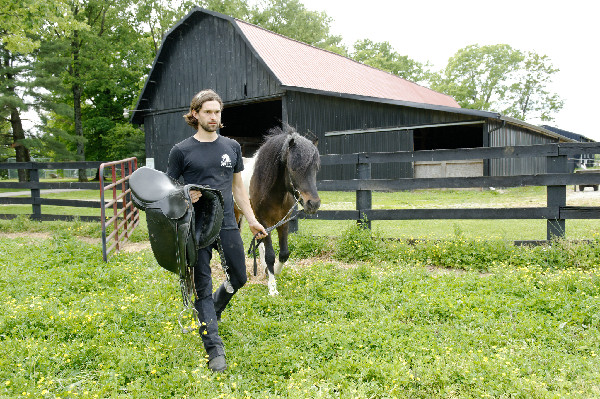
Gudmar Petursson trains Icelandics on his two farms, one of which is in Kentucky and another is in Iceland. Photo by Peter Kneffel.
I’m also a little bit of an adrenaline junkie. I competed a lot as a kid, so I kind of need that excitement. I like the preparation, waiting at the gate, going in and hoping that it goes well. It’s that excitement you also get out of a competition.
I’m also into the marketing part, so I like helping promoting the show and promoting my breed as I ride in the show. I’m representing my breed, I’m representing myself, and I’m representing my country. I like that challenge too. When we were creating the Knights of Iceland team, we worked with costume specialists and designers. Putting together the creative concept is something that I really enjoy, especially taking it in front of people and getting positive feedback.
When things go well, it is very rewarding. When we get a standing ovation, that means we have something that everybody enjoys. You put a lot of work into it, and this is how it pays off. Now, after getting to see the production at Apassionata, I learned that there’s even more to it than I ever thought there was.
Equitrekking: What are the biggest challenges you’ve faced in your career?
Gudmar Petursson: The biggest challenge for me is that there’s a lot that I want to do. I’ve got a lot of ideas in my head. Once I reach one goal, I’m thinking about the next one. I have to remind myself that there’s only so much somebody can do. I’m extremely fortunate in how many good people I’m surrounded by. I realized a long time ago that it’s very limited what one man can do.
I have to be careful not to overload myself. I live on two continents, in two parts of the world. I mostly live in Kentucky, but I go back to Iceland a few months each year. To have a home in two countries, to manage several businesses and to make everything run smoothly takes work. I have to say I think it’s going well, but I have to be careful not to take on too much and to know my limits. I’m not a superman. Sometimes you have to choose what you really want to do and what you’re going to do less.
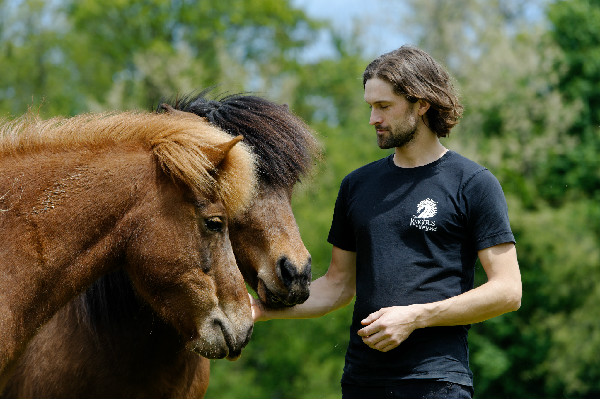
Gudmar Petursson moved to Kentucky to be at the center of the horse world. Photo by Peter Kneffel.
I’m slowly learning to pace myself and prioritize things. I’m not just a performer, I’m not just a tour guide, and I’m not just an instructor. It’s a little bit complicated sometimes because I have many irons in the fire. At the same time for me, I need that. I need to have a lot going on, and I want to have a lot going on. I work a lot, but at the same time I don’t feel like I’m working. Obviously there are things that I might not enjoy as much as others, but I’m doing something that I chose. I never wake up in the morning dreading to go to work. Yes, I might be tired, but I’m still wanting to do what I need to do.
Equitrekking: What are your biggest challenges as a performer?
Gudmar Petursson: You have to be prepared, and you have to always do a good job. It doesn’t matter how you’re feeling or how you’re doing. You have to keep up the quality. It’s about how high your expectations are. You can’t say, well, I haven’t had such a good day today, so I don’t care. Even if you feel a bit sick, you have to go in there and perform. It can be tough sometimes.
When you have a team of people, it’s very important to have a good atmosphere. It doesn’t matter how good the riders are or how good the horses are, if there’s a bad feeling in the group, the show will not be as good. You have to be very careful. I try to choose people who I think can work together. Then I do my best to keep everybody happy, horses and riders, and encourage people but at the same time still have expectations.
You have to always be on your toes. I think we have a pretty good team of horses, but we are also putting sparklers on their legs. That’s all very accurate and detailed work. There’s no room for error. At the same time, we have a lot of fun.
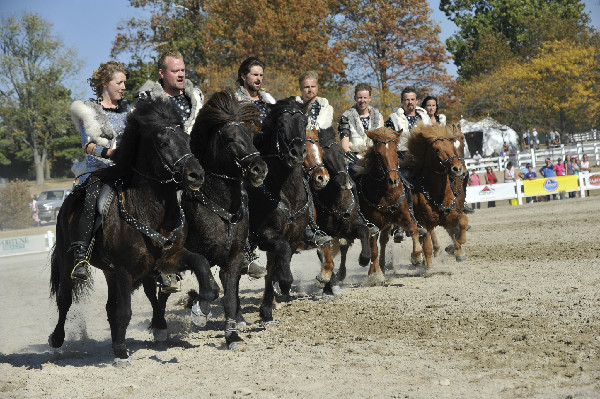
The Knights of Iceland perform complex drill patterns aboard their calm Icelandics. Photo by Astrid Harrisson.
One common thing with everybody in my group, which I know for sure, is that nobody is there because they have to be there. Everybody is there because they have a passion for what they do.
I think that’s what horsemanship is about. I don’t know many trainers or performers with horses who do it just because it’s a way of living. They chose that way of living. It’s a very hard way to make a living, as far as workload goes. I say to everybody that if you don’t really enjoy it, and you’re not ready to put the work in, then find another job right away. When you enjoy it, like me, you put in many more hours. It’s an interesting way to make a living, but not an easy way.
Equitrekking: What’s the best way to become a horse trainer?
Gudmar Petursson: I get a lot of interns and kids who come here for lessons and work with us. Pretty soon I can usually tell the ones who are likely to keep going with it and the ones who will take lessons and then move on to something else. You see that passion, you see that endless interest in the horse, and a never-ending need to learn about the animal and figure it out. These kids fall asleep thinking about horses. They wake up thinking about horses. They can’t get enough somehow. It’s like an addiction, but a good one I think.
I tend to remind my people that there are many ways to work with horses. You can be a trainer, teacher, competitor, performer, trekking host, farrier, dentist or veterinarian. There’s not only the fact that you have to just train all day long. It’s important to realize that.

Gudmar Petursson and his daughter pet Icelandics at his farm in Kentucky. Photo by Peter Kneffel.
With horses, nothing replaces experience. You’re dealing with live animals. None of them are the same, and no two of them are alike. The only way to become good at it is to work with as many different horses as you possibly can. Practice makes perfect, but on the other hand, it’s also important to practice right. If you practice incorrectly, the way to success becomes longer.
Getting good instruction is a very important base. Try to locate a good trainer. Obviously they are very different, and different can be good, but try to get a good trainer. Learn the basics correctly and then educate yourself.
We say in riding instruction that it takes you 200 years to become a good rider. We all have a long way to go. If you meet a trainer who knows it all, I would go to another one. I think it’s very important to be open-minded, to be willing to explore. As some instructor said, “If I know it’s not going to hurt me, if I know it’s not going to hurt my horse, I’m willing to try it.” Open-minded trainers are willing to see other things, willing to try different things, willing to listen to different things and open for discussion. I’ve seen that those trainers are usually good. I say that when I stop learning, that’s when I become bad.
Learn the right way as quickly as you can, because that’s the fastest route. Then it’s just a matter of getting as much experience and exposure as you possibly can. You have to try to get good, correct knowledge, and then just try to get experience as much as possible. Work with these animals and always be open to ideas. However, don’t let somebody fool you into something ridiculous. You have to be smart enough to know the difference between something that might potentially be a good idea and something that is ridiculous. That’s where the education comes in.
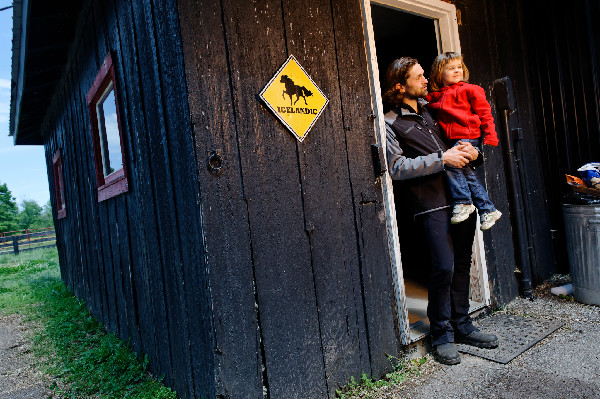
Petursson and his show team Knights of Iceland are based near Louisville, Kentucky. Photo by Peter Kneffel.
It takes a lot to become very good at it, because it doesn’t matter how many books you read or how many clinics you take. Obviously that all helps a lot, but you need the experience. That’s what makes you stand out. Try to practice as much as you can, but practice right.
You’re going to work with trainers and see how that life is, and you’re going to think to yourself, “Is this what I really want?” Some would say yes, this is my dream life. Some would say I’m going to do this on the side and have a different job. And that’s fine too. You have to kind of figure out where you want to place yourself in this world. There are many ways to be a horse person without making it your living.
Equitrekking: What is the best way to become an equestrian performer?
Gudmar Petursson: What I try to do with the Icelandic Horses is to focus on showing something that my breed is good at doing, something that my breed can do that other breeds cannot do. I’m not trying to imitate others. You have Icelandic Horses that are good at certain things, but they’re not as good in other things. If I wanted to show dressage, I wouldn’t get an Icelandic Horse. I think you have to find a niche.
The interesting thing is also that it doesn’t have to be rocket science or almost impossible. You have to be able to do it in a beautiful way, and you have to do something that not everybody’s doing. Obviously do something unique, but it doesn’t mean that it’s magic.

Gudmar Petursson performs the flying pace at a horse show. Photo by Martina Gates of Aska.
You have to be really good at what you do, but it’s all built on solid horsemanship method. It’s about having a good relationship between the horse and the rider, and that proves what amazing things can happen. Everything is possible, that’s what I always say to my kids and say to myself. Nothing is impossible, and you just have to figure out ways to do it.
The horses I have are really good horses, but there are a lot of other horses like that out there. My horses are not aliens. They are just really good Icelandic Horses. We found a way to teach them something that not everybody’s been doing. It’s not like I have to have a $500,000 horse that is one of a kind in the world. It’s much more about the relationship between the horse and the rider. A lot of the horses you see such as in Apassionata are just regular horses. They are good quality horses, but what distinguishes them and the performances from regular riding is that the riders have a special relationship with the horses. That’s how they can get them to do something that not every ordinary person can do.
The magic is to have the relationship between the horse and the rider. The rider has to understand horses, know what his horse is accustomed to, and know what situations he can put him into without harming anything. If the horse trusts you, you can try almost anything and do almost anything with the horse. If you fail him and you break that trust, he won’t let you do it again.
I’m more concerned about being a good horse person than I am about being a performer. Sometimes when people see amazing things, they think to themselves, boy, this guy was lucky to get that horse, when maybe the horse was lucky to get that rider. That’s not the trick, necessarily, to find that magic situation. It’s being good at what you do.
Equitrekking: What would you say to someone seeking a dream job with horses?
Gudmar Petursson: I’ve always had dreams myself, and I’m following them. That’s one of the reasons I’m here. I say to my kids and my intern staff that you have to figure out what you want to do, and then don’t let anybody tell you that you can’t do it. If I would have told somebody many years ago that I was going to put sparklers on Icelandics and ride in front of thousands of people, they would have laughed at me. But it’s been in my head for a very long time. Don’t let go of it. It doesn’t mean you have to sacrifice everything at that moment and go for your dream. It might modify, and it might change. It takes time, and sometimes to make a living you have to do other things. Just don’t let go of the dreams.
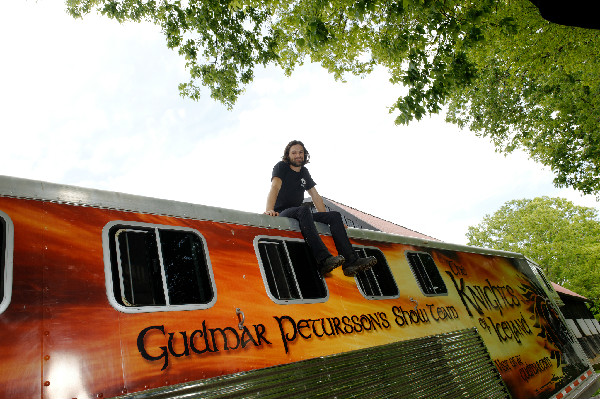
The Knights of Iceland show team travels to large equine expos. Photo by Peter Kneffel.
My family has always supported me. I can tell you that with my kids, I’m going to support them in doing whatever they want to, even if it might sound crazy, as long as it’s something healthy. I think that’s the way you get where you want to get. If you see that a kid has the passion for something, I think the best thing that everyone around them can do is support them. For example with the horses, you can have a passion for horses but it doesn’t mean that you have to just become a horse trainer. Yes, you have to know horses, but you can take that in so many directions to do what’s within your passion. That’s what I believe, anyway.
Learn more about the Knights of Iceland and contact Gudmar Petursson at gudmar.com.
Karen Braschayko is a freelance writer and horse lover who lives in Michigan.




